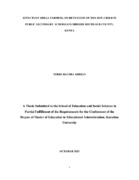| dc.description.abstract | The Government of Kenya, in its efforts to achieve vision 2030, aims at improving
retention rates in secondary schools. This effort however is frustrated by increasing
dropout rates particularly in public secondary schools, which is attributed to a number of
factors among them cultural, environmental, school, based and socio economic. The
purpose of this study was to investigate the effects of miraa farming on the retention of
the boy-child in public secondary schools particularly in Mbeere South Sub-County,
Kenya. The objectives of the study were: to establish the socio-economic factors, to
evaluate the effects of socio-cultural factors and to assess the effects of family factors
related to miraa farming affecting school retention of boy child in public secondary
schools in Mbeere-South Sub-County. The study was guided by the Social Systems
Theory. The study employed a descriptive research design. The location of the study was
specifically the miraa growing areas of Mbeere South Sub County. The study population
included 56 principals, 140 class teachers, and 24 local administrators. The sample
included 12 principals, 140 teachers and eight local administrators. Twelve schools from
the miraa growing areas of Mbeere South Sub-Couny were purposively sampled for the
study. Purposive sampling was also employed to select the 12 principals and eight local
administrators while stratified random sampling was used to select 36 teachers from
specific schools. Questionnaires were used to collect data. Cronbach’s alpha coefficient
was used to measure the reliability of the questionnaire. Qualitative data was analyzed
through content analysis. Quantitative data was analyzed using descriptive statistics such
as percentages, means and standard deviations and was presented by use of frequency
distribution tables. The study found that students drop out to seek employment in miraa
farms/ businesses. Reasons for dropping out of school were cited as inability to raise
school fees and other levies due to the United Kingdom ban of miraa exportation.
Further, the study found that the society regards miraa farming/ business higher than
school attendance. Finally, the findings of the study demonstrated that families in the area
rely heavily on labor from their children to tend their miraa farms. Based on the findings
of the study, the Ministry of Education may develop policies that may streamline the
retention of the boy-child in public secondary schools. | en_US |
